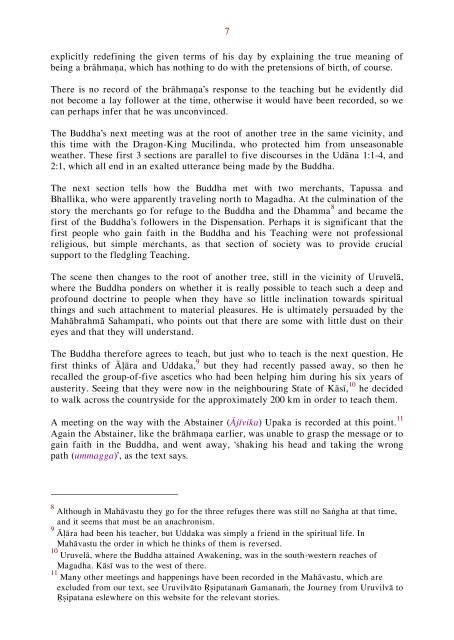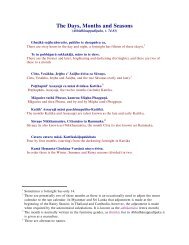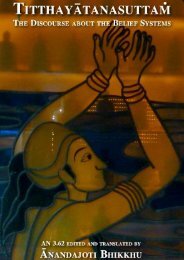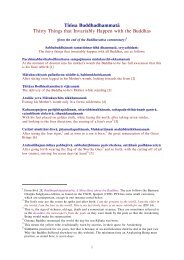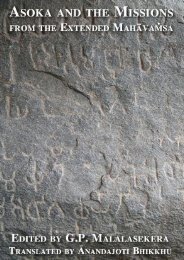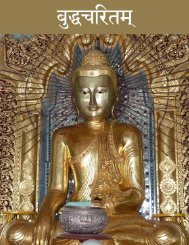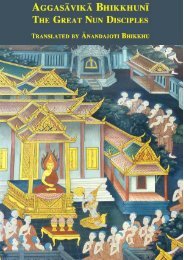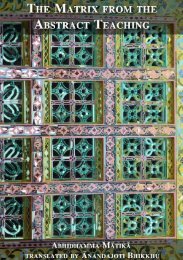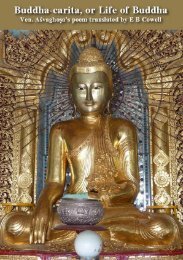MahÄkhandhako The Great Chapter - Ancient Buddhist Texts
MahÄkhandhako The Great Chapter - Ancient Buddhist Texts
MahÄkhandhako The Great Chapter - Ancient Buddhist Texts
You also want an ePaper? Increase the reach of your titles
YUMPU automatically turns print PDFs into web optimized ePapers that Google loves.
7<br />
explicitly redefining the given terms of his day by explaining the true meaning of<br />
being a brāhmaṇa, which has nothing to do with the pretensions of birth, of course.<br />
<strong>The</strong>re is no record of the brāhmaṇa’s response to the teaching but he evidently did<br />
not become a lay follower at the time, otherwise it would have been recorded, so we<br />
can perhaps infer that he was unconvinced.<br />
<strong>The</strong> Buddha’s next meeting was at the root of another tree in the same vicinity, and<br />
this time with the Dragon-King Mucilinda, who protected him from unseasonable<br />
weather. <strong>The</strong>se first 3 sections are parallel to five discourses in the Udāna 1:1-4, and<br />
2:1, which all end in an exalted utterance being made by the Buddha.<br />
<strong>The</strong> next section tells how the Buddha met with two merchants, Tapussa and<br />
Bhallika, who were apparently traveling north to Magadha. At the culmination of the<br />
story the merchants go for refuge to the Buddha and the Dhamma 8 and became the<br />
first of the Buddha’s followers in the Dispensation. Perhaps it is significant that the<br />
first people who gain faith in the Buddha and his Teaching were not professional<br />
religious, but simple merchants, as that section of society was to provide crucial<br />
support to the fledgling Teaching.<br />
<strong>The</strong> scene then changes to the root of another tree, still in the vicinity of Uruvelā,<br />
where the Buddha ponders on whether it is really possible to teach such a deep and<br />
profound doctrine to people when they have so little inclination towards spiritual<br />
things and such attachment to material pleasures. He is ultimately persuaded by the<br />
Mahābrahmā Sahampati, who points out that there are some with little dust on their<br />
eyes and that they will understand.<br />
<strong>The</strong> Buddha therefore agrees to teach, but just who to teach is the next question. He<br />
first thinks of Āḷāra and Uddaka, 9 but they had recently passed away, so then he<br />
recalled the group-of-five ascetics who had been helping him during his six years of<br />
austerity. Seeing that they were now in the neighbouring State of Kāsī, 10 he decided<br />
to walk across the countryside for the approximately 200 km in order to teach them.<br />
A meeting on the way with the Abstainer (Ājīvika) Upaka is recorded at this point. 11<br />
Again the Abstainer, like the brāhmaṇa earlier, was unable to grasp the message or to<br />
gain faith in the Buddha, and went away, ‘shaking his head and taking the wrong<br />
path (ummagga)’, as the text says.<br />
8 Although in Mahāvastu they go for the three refuges there was still no Saṅgha at that time,<br />
and it seems that must be an anachronism.<br />
9 Āḷāra had been his teacher, but Uddaka was simply a friend in the spiritual life. In<br />
Mahāvastu the order in which he thinks of them is reversed.<br />
10 Uruvelā, where the Buddha attained Awakening, was in the south-western reaches of<br />
Magadha. Kāsī was to the west of there.<br />
11 Many other meetings and happenings have been recorded in the Mahāvastu, which are<br />
excluded from our text, see Uruvilvāto Ṛṣipatanaṁ Gamanaṁ, the Journey from Uruvilvā to<br />
Ṛṣipatana eslewhere on this website for the relevant stories.


